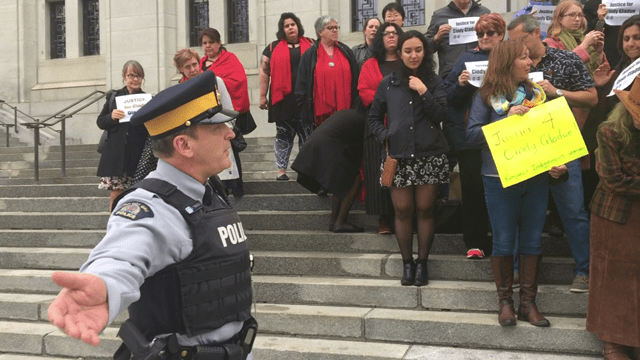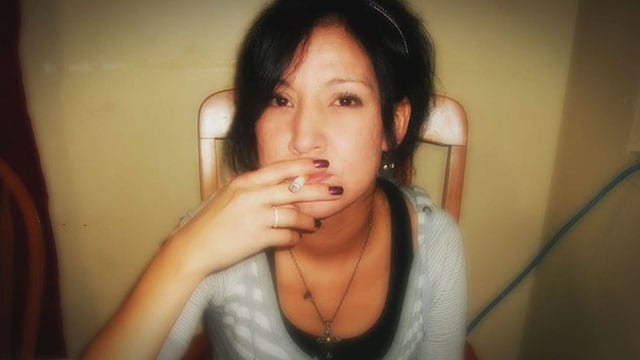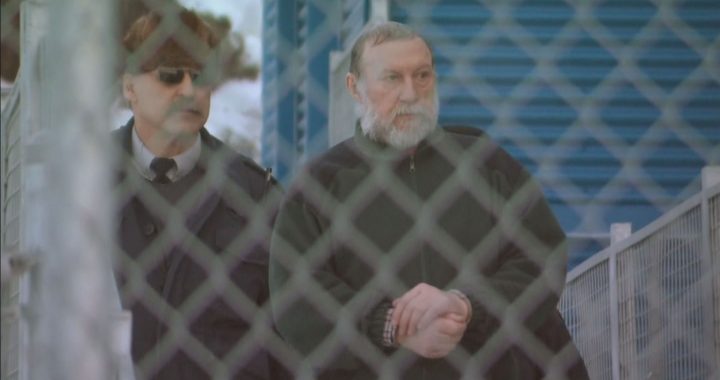
An RCMP officer interrupts a song and ceremony on the steps of the Supreme Court of Canada Oct. 11, 2018, where people had gathered to demand justice for Cindy Gladue. Justin Brake/APTN photo.
It will be months before the Supreme Court of Canada releases a decision on the case of Bradley Barton, the man acquitted in 2015 of first-degree murder and manslaughter in the death of Cindy Gladue, a Mohawk lawyer and long time advocate for Indigenous women’s rights says last week’s hearing represents “a little bit of a shift” in the way Canada’s legal system understands the realities Indigenous women and girls face and of the ongoing impacts of colonization.
At the same time, Beverly Jacobs told APTN News in a phone interview Monday, events that unfolded outside the courthouse on Thursday revealed the “huge distance” between what is heard in courtrooms and the lived realities of Indigenous people in Canada.
Jacobs, a law professor at the University of Windsor and former president of the Native Women’s Association of Canada, was part of the legal team representing the Institute for the Advancement of Aboriginal Women and the Women’s Legal Education and Action Fund, who are intervenors in the case.
The two groups told the court Thursday that Gladue could not have consented to the actions by Barton that ultimately killed her.
During a break for the nearly four-hour hearing Jacobs joined Indigenous women and other grassroots people outside on the Supreme Court’s front steps, where about two dozen people had gathered for a peaceful demonstration to demand justice for Gladue.
Women led the group in song and ceremony, but moments after they began an RCMP officer interrupted and asked them to move.
They reluctantly obeyed, ending the ceremony to move about three metres away where the cop had gestured to stand.
Moments later though, three women returned to the steps and sang the Mi’kmaq Honour Song, in what Jacobs calls a display of the strength of Indigenous women and the determination of grassroots people in their fight to end violence against Indigenous women and girls.
“Our woman are saying that’s enough and you’re not going to shut me up, you’re not going to move me, and we’re going to continue to do what we need to do.”
Video of the event, posted by APTN on social media, has been viewed more than 20,000 times.
“This scene hasn’t changed in hundreds of years. The white man asking Indigenous people to leave a public space while their families are getting killed,” one person commented.
Many have referenced the incident as a metaphor for the relationship between Indigenous people and Canada’s justice system.
Even former RCMP Commissioner Bob Paulson, for years the federal police’s top cop, summarized the video on Twitter with one word: “Canada”.
Canada https://t.co/ZV3d8gH2m7
— Bob Paulson () October 11, 2018
Jacobs says forcing women in ceremony off the court’s steps demonstrated the legal system’s “lack of respect for Indigenous women” while highlighting a pervasive attitude in Canada toward Indigenous people.
She says in moving people off the steps the officer was likely prioritizing “the property of the Supreme Court of Canada [over] the humanness of the people who are trying to bring attention to the injustices and the dehumanization of Cindy Gladue.”
More than a murder trial
The Supreme Court will decide whether Barton, who admitted to killing Gladue after a night of what he testified was rough but consensual sex in 2011, will face a new trial.
The outcome will also likely impact Indigenous people’s growing sense of outrage at Canada’s justice system, and whether and to what extent, it is becoming more just for them.
It’s one of a few recent high profile cases in Canada involving a white man being acquitted after killing an Indigenous person. Earlier this year in Saskatchewan Gerald Stanley was acquitted of second-degree murder after shooting and killing Colten Boushie, and Raymond Cormier was found not guilty of second-degree murder in the death of Tina Fontaine in Winnipeg.
The verdicts in all three cases sparked nationwide protests.
In 2017, Alberta’s Court of Appeal overturned the provincial court’s 2015 Barton verdict and ordered the accused to face a new trial.
In their decision the judges said the trial judge made procedural errors in not invoking the rape-shield law and in failing to properly instruct the jury of nine men and two women, who heard throughout the trial that Gladue was both Indigenous and a sex trade worker.
“The trial judge ought to have addressed the repeated references to Gladue as a ‘Native’ girl and ‘prostitute’ to overcome the real risk of reasoning prejudice,” the judges wrote.
Canada’s rape-shield law also sets rules for the introduction of a person’s sexual history as evidence in sexual assault cases. Several Supreme Court judges expressed concern with the trial judge’s failure to hold a separate hearing without the jurors to determine if Gladue’s encounter with Barton the night prior to her death should be admitted as evidence. The admission of this encounter, Justice Andromache Karakatsanis said Thursday, may have led jury members to believe Gladue was more likely to consent to the actions which led to her death.
Several of the 16 intervenors in Supreme Court raised the issue of prejudice towards sex workers and Indigenous people. During the 2015 trial lawyers for the defense and the Crown, as well as witnesses, all referred to Gladue as a Native woman and a prostitute.
At Thursday’s demonstration outside the courthouse, Qajaq Robinson, a commissioner with the National Inquiry into Missing and Murdered Indigenous Women and Girls, which is intervening in the case, told APTN the Inquiry is hearing that “the justice system isn’t protecting [Indigenous women] against racism, sexism and stereotypes.
“It was important that the issues that we’re hearing about and how the law plays a role was brought to light during this hearing,” she said.
“There’s no place in a justice system for racism and sexism to seep into the process.”
Consent a determinant in whether Barton will face new trial
The issue of consent is central to the case, including questions around Gladue’s level of intoxication, when and how she may have consented to sexual activity with the defendant, and ultimately whether Gladue consented—or could even consent—to the act that led to her death.
In the event of a retrial, the answer to the question of consent will determine whether Barton is convicted of first-degree murder, manslaughter, or is found not-guilty.
In their submissions to the Supreme Court the Crown argues that the trial judge should have informed the jury that Barton could be found guilty of manslaughter if they determined the defendant should have foreseen that his actions toward Gladue risked causing bodily harm.
At trial Barton, a truck driver from Ontario who was in Edmonton for work, testified that he consensually penetrated Gladue manually during his paid sexual encounter with her in a motel room. The Crown argued that Gladue was intoxicated, and that Barton either inserted a knife or other sharp object into Gladue’s vagina or used an amount of force with his fist that he should have known would harm her.

In their decision the Alberta appellate judges wrote that the case “has exposed the flaws in the legal infrastructure used for instructing juries on sexual offences in Canada,” and that “the time has come to push the reset button for jury charges in this country for cases involving an alleged sexual assault.”
Barton’s lawyers have countered, arguing in Supreme Court last week that the Crown made new arguments in its appeal, and that subsequently the Alberta appellate court overstepped its jurisdiction in citing its own objections to the trial judge’s actions beyond those raised by the Crown.
The Supreme Court justices didn’t focus on concerns around the language used to describe Gladue, or on the fact a preserved part of her corpse was used as evidence of the 11-centimetre cut in her vaginal wall—which many have cited as an indignity to Gladue.
But several did challenge the defense on their arguments against the appellate court’s finding that the trial judge erred in not evoking the rape-shield law, which may have prevented the jury from hearing testimony about Gladue’s past sexual history.
Barton’s lawyers argued that their client facing a new trial will amount to double jeopardy.
The case has the potential to change sexual assault and consent laws in Canada.
Indigenous women lead long fight for justice
Outside on the front steps of the Supreme Court, folks gathered around long-time advocate for Indigenous women’s rights Muriel Stanley Venne.
“This is not a new problem,” she said, referring to the issue of missing and murdered Indigenous women and girls.
“And I say we’re on the brink of success, by everyone that is here to do the work that has to be done.”
Jacobs, who was lead author of Amnesty International’s 2004 Stolen Sisters Report and is a 2018 recipient of the Order of Canada, says as a lawyer and advocate she’s keenly aware that Indigenous women have led the long fight for justice, and that “it’s such a constant battle, even for the courts to understand the issues.”
She says “law itself was used as a tool to erase us as a people,” alluding to residential schools and other legislated policies and efforts to assimilate Indigenous people.

Jacobs says she gives the Supreme Court justices the benefit of the doubt, but that she was disappointed by the court’s scheduling overlap with the Mikisew First Nation duty to consult decision and the Gladue hearing.
“In the media all the attention was drawn to the Mikisew Cree case and not to this appeal.”
At one point during the interview Jacobs corrects herself in the process of saying the words “justice system”.
“I refuse to call it a justice system at this time because there has been no justice in the legal system for Indigenous people overall, but especially Indigenous women and girls and victims of violence.
Venne acknowledged the work Indigenous women have done.
She also said Canadians have a role to play, and that the treatment of Gladue before and after her death should be an impetus for action.
“It wasn’t enough that they violated her when she was living, but they also violated her when she was dissected and her vagina brought into the courtroom,” Venne told those gathered around her.
“Everybody, every Canadian, has to be appalled and determined to change that.”











To get an honest response from a jury concerning anything ‘native’ as a victim is to have all defendents native and Importantly non native too, to be covered, sexless, change of voice, name, location and more tell tale triggers jurors may pick up on. In this way racial factors contributing to verdicts, subconsciously overtly would be eradicated. Only then will the facts take hold u hindered by opinions.
To get an honest response from a jury concerning anything ‘native’ as a victim is to have all defendents native and Importantly non native too, to be covered, sexless, change of voice, name, location and more tell tale triggers jurors may pick up on. In this way racial factors contributing to verdicts, subconsciously overtly would be eradicated. Only then will the facts take hold u hindered by opinions.